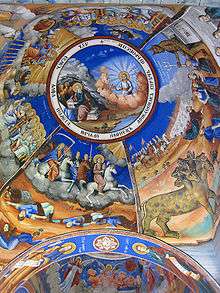Apocalypse
| Part of a series on |
| Eschatology |
|---|
|
|


An apocalypse (Ancient Greek: ἀποκάλυψις apokálypsis, from ἀπό and καλύπτω, literally meaning "an uncovering") is a disclosure of knowledge or revelation. In religious contexts it is usually a disclosure of something hidden, “a vision of heavenly secrets that can make sense of earthly realities".[1]
In the Book of Revelation (Greek: Ἀποκάλυψις Ἰωάννου, Apokalypsis Ioannou – literally, John's Revelation), the last book of the New Testament, the revelation which John receives is that of the ultimate victory of good over evil and the end of the present age, and that is the primary meaning of the term, one that dates to 1175.[2]
Today, it is commonly used in reference to any prophetic revelation or so-called end time scenario, or to the end of the world in general.
Biblical ideas
Dreams
The revelation may be made through a dream, as in the Book of Daniel, or through a vision, as in the Book of Revelation. In biblical accounts of revelations the manner of the revelation and its reception is generally described.
According to the Book of Daniel, after a long period of fasting,[3] Daniel is standing by a river when a heavenly being appears to him, and the revelation follows (Daniel 10:2ff).
Symbolism
Symbolism is a frequent characteristic of apocalyptic writing. One instance of this occurs where gematria is employed, either for obscuring the writer's meaning or enhancing it; as a number of ancient cultures used letters also as numbers (i.e., the Romans with their use of "Roman numerals"). Thus the symbolic name "Taxo," "Assumptio Mosis", ix. 1; the "Number of the Beast" (616/666), in the Book of Revelation 13:18;[4] the number 666 ('Iησōῦς), Sibyllines, i.326–30. In religious senses the four horsemen of the apocalypse can all be said to symbolize different aspects of what people believe will happen.These nare death famine war and conquest. Each having a deeper meaning into how the world will crumble.[(http://lifehopeandtruth.com/prophecy/end-times/four-horsemen-of-the-apocalypse/)]
Similar is the frequent prophecy of the length of time through which the events predicted must be fulfilled. Thus, the "time, times, and a half," Daniel 12:7[5] which has been taken to be 3½ years in length by Dispensationalists; the "fifty-eight times" of Enoch, xc.5, "Assumptio Mosis", x.11; the announcement of a certain number of "weeks" or days, which starting point in Daniel 9:24, 25 is "the going forth of the commandment to restore and to build Jerusalem unto the Messiah the Prince shall be seven weeks",[6] a mention of 1290 days after the covenant/sacrifice is broken (Daniel 12:11),[7] 12; Enoch xciii.3–10; 2 Esdras 14:11, 12; Apocalypse of Baruch xxvi–viii; Revelation 11:3, which mentions "two witnesses" with supernatural power,[8] 12:6;[9] compare Assumptio Mosis, vii.1. Symbolic language is also used to describe persons, things or events; thus, the "horns" of Daniel 7 and 8;[10] Revelation 17[11] and following; the "heads" and "wings" of 2 Esdras xi and following; the seven seals of Revelation 6;[12] trumpets, Revelation 8;[13] "vials of the wrath of God" or "bowl..." judgments, Revelation 16;[14] the dragon, Revelation 12:3–17,[15] Revelation 20:1–3;[16] the eagle, Assumptio Mosis, x.8; and so on.
End of the age


In the Hebrew Old Testament some pictures of the end of the age were images of the judgment of the wicked and the glorification of those who were given righteousness before God. In the Book of Job and in some Psalms the dead are described as being in Sheol, awaiting the final judgment. The wicked will then be consigned to eternal suffering in the fires of Gehinnom, or the lake of fire mentioned in the Book of Revelation.[14][17][18][19][20]
See also
- Apocalypse Series (Kanso)
- Apocalyptic and post-apocalyptic fiction
- Christian eschatology
- Hindu eschatology
- Human extinction
- Islamic eschatology
- List of dates predicted for apocalyptic events
- Messianic Age
- Ragnarök
- Ultimate fate of the universe
References
- ↑ Bart D. Ehrman, "How Jesus Became God", pg. 59, ISBN 978-0-06-177818-6
- ↑ Oxford English Dictionary, A, Oxford University Press, p. 386
- ↑ "Daniel 10:1–4 (King James Version)". Bible Gateway. Retrieved 2007-11-15.
- ↑ "Revelation 13:16–18 (King James Version)". Bible Gateway. 2012. Retrieved 2007-11-21.
- ↑ "Daniel 12:7 (King James Version)". Bible Gateway. Archived from the original on 2007-12-09. Retrieved 2007-11-21.
- ↑ "Daniel 9:24–25 (King James Version)". Bible Gateway. Retrieved 2007-11-21.
- ↑ "Daniel 12:11 (King James Version)". Bible Gateway. Archived from the original on 2007-11-05. Retrieved 2007-11-21.
- ↑ "Revelation 11:3 (King James Version)". Bible Gateway. Archived from the original on 2007-12-09. Retrieved 2007-11-21.
- ↑ "Revelation 12:6 (King James Version)". Bible Gateway. Archived from the original on 2007-12-09. Retrieved 2007-11-21.
- ↑ "Daniel 7; Daniel 8 (King James Version)". Bible Gateway. Archived from the original on 2007-12-09. Retrieved 2007-11-21.
- ↑ "Revelation 17 (King James Version)". Bible Gateway. Archived from the original on 2007-12-09. Retrieved 2007-11-21.
- ↑ "Revelation 6 (King James Version)". Bible Gateway. Archived from the original on 2007-11-15. Retrieved 2007-11-21.
- ↑ "Revelation 8 (King James Version)". Bible Gateway. Archived from the original on 2007-12-09. Retrieved 2007-11-21.
- 1 2 "Revelation 16 (King James Version)". Bible Gateway. Archived from the original on 2007-12-08. Retrieved 2007-11-21.
- ↑ "Revelation 12:3–17 (King James Version)". Bible Gateway. Retrieved 2007-11-21.
- ↑ "Revelation 20:1–3 (King James Version)". Bible Gateway. Retrieved 2007-11-21.
- ↑ "Revelation 19:20 (King James Version)". Bible Gateway. Archived from the original on 2007-11-07. Retrieved 2007-11-21.
- ↑ "Revelation 20:10 (King James Version)". Bible Gateway. Archived from the original on 2007-12-09. Retrieved 2007-11-21.
- ↑ "Revelation 20:14–15 (King James Version)". Bible Gateway. Retrieved 2007-11-21.
- ↑ "Revelation 21:8 (King James Version)". Bible Gateway. Archived from the original on 2007-11-24. Retrieved 2007-11-21.
Further reading
- Morris, Henry M (1985) [1983]. The Revelation Record. Tyndale House and Creation Life.
External links
- The Apocalypse on In Our Time at the BBC. (listen now)
- It's the End of the World: 8 Potential Armageddons, Fox, Sep 29, 2010.
- Bible. N.T. Revelation. Latin. Selections. 1470. Apocalypsis Sancti Johannis. Germany, ca. 1470 48 leaves. illus. 31 cm. From the Rare Book and Special Collections Division at the Library of Congress
